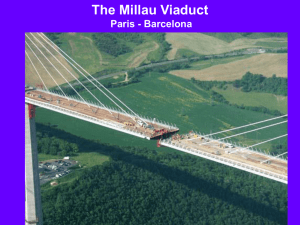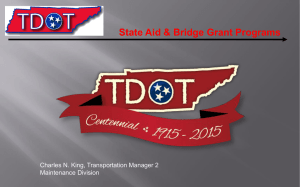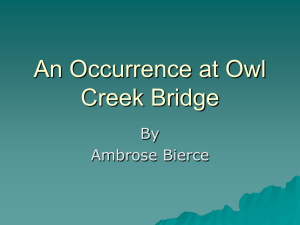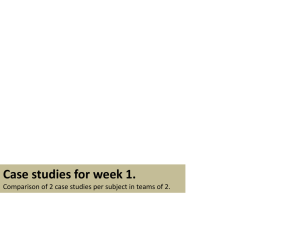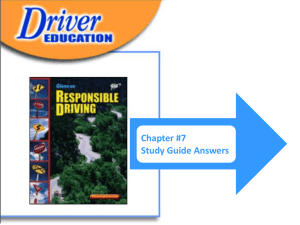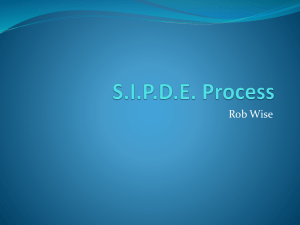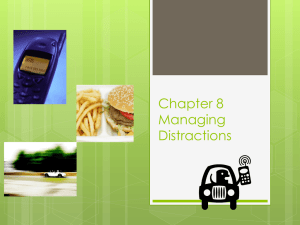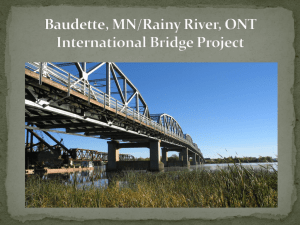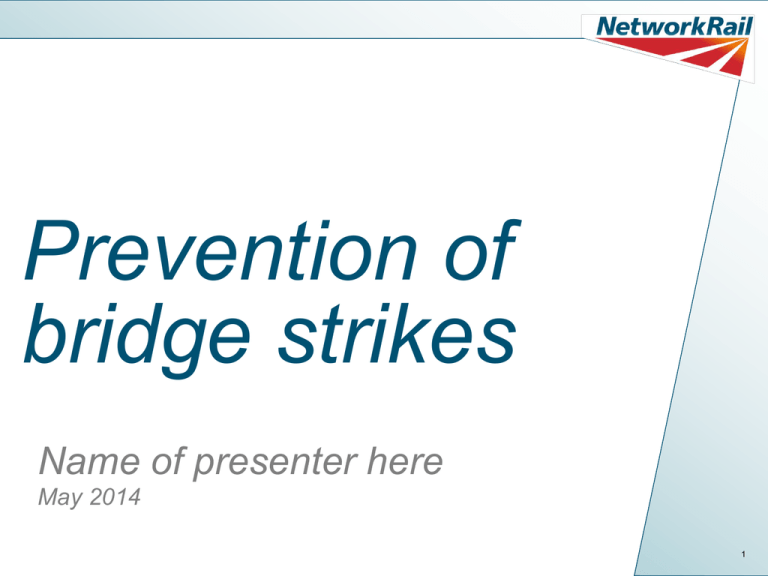
Prevention of
bridge strikes
Name of presenter here
May 2014
1
Introduction and
background
Section number to go here
May 2014
2
Overview of the course
• Introduction and background
• The Law
• Vehicle height measurement
• Journey planning and routing
• Traffic signs
• On the road
• Reporting a bridge strike
• Consequences of a bridge
strike
• Practical training
May 2014
3
Definition
• What is a bridge strike?
– A bridge strike is an incident in which a vehicle, its load or
equipment collides with a bridge
May 2014
4
A few key questions
1. How many bridge strike incidents do you think happen each
year?
2. Have you ever known of anyone who has experienced a bridge
strike? Do you know what happened? Do you know what
caused it?
3. If your vehicle hits a bridge, who might this affect?
4. A bridge with diminishing headroom and a skew bridge are
particularly hazardous – why do you think this is?
5. What do you think causes bridge strikes?
6. Does anyone know what the law is in relation to displaying the
vehicle height in the driver’s cab?
7. Why are round and triangular signs used at low bridges?
May 2014
5
Why bridge strikes?
May 2014
6
Oyne
12th May 1978
May 2014
7
Bridge strikes at rail over road bridges
2500
Number of Reported Bridge Strikes
2148
1984
2000
2040
1917
1902
1614
1650
1629
1645
2010
2011
2012
2013
1432
1500
1000
500
0
2004
2005
2006
2007
2008
2009
Year
May 2014
8
Time of reported bridge strikes
Bridge Strikes by Hour
250
Number
200
150
100
50
0
1
2
3
4
5
6
7
8
9
10 11 12 13 14 15 16 17 18 19 20 21 22 23 24
Hour in Day
May 2014
9
Bridges over the road
Bridge with flat soffit
Arch bridge
Collision protection beam
May 2014
10
Bridge types
Arch bridge with
diminishing headroom
along the road
Bridge type varies along the road
Skew bridge
May 2014
11
Driver survey – causes of bridge strikes
What do you think are the main
causes of high vehicles hitting
low bridges?
• Drivers not knowing vehicle height
• Drivers not believing signs
• Inadequate signing
• Poor information about low bridges
when planning a route
• Poor route planning
• Drivers not understanding signs
• Other
May 2014
12
The law
Section number to go here
May 2014
13
Vehicle height notice in cab
• the maximum travelling height of the
vehicle must be displayed on a notice (in
a prominent position) in the cab of a
vehicle when the overall travelling height
of the vehicle, it load or equipment
exceeds than 3 metres (10 feet):
– in feet and inches, or in both feet and
inches and metres
– not less than the overall travelling
height of the vehicle
– not more than 150 mm above the
overall travelling height of the vehicle
• applies when trailers are being towed
May 2014
14
Equipment alarm
• vehicles with high level equipment with a maximum
height more than 3 metres must be fitted with a device
to give a visible warning to the driver if the equipment
is raised whilst being driven, unless the equipment can
be fixed in position by a locking device.
May 2014
15
Traffic signs
• if a vehicle is higher than the dimensions
shown on a circular traffic sign, the driver
must stop and must not pass the sign
• if the vehicle is higher than the
dimensions shown on a triangular traffic
sign at the bridge, the driver should not
pass the sign.
May 2014
16
Reporting a bridge strike
• any road traffic collision that causes damage to a 3rd party is
required to be reported
• each bridge strike will cause damage to a bridge, and must
therefore be reported.
May 2014
17
Vehicle height
measurement
Section number to go here
May 2014
18
Driver survey – vehicle height
Do you use any devices to measure the height of your vehicle?
• 69% of drivers do not use anything
• Drivers often rely on others for this information
• 25% use a non digital measuring device
“...in 15 years of HGV driving I’ve never seen a regular low
loader HGV driver other than a car transporter driver in
possession of a proper measuring stick” ... “regular low loader
drivers don’t even get a tape measure issued to them!”
May 2014
19
Overall travelling height
• what is overall travelling
height?
– greatest height measured
from ground level to the
highest part of the vehicle,
its load or equipment
• applies to a vehicle and trailer
combination
May 2014
20
Vehicle, load and equipment height
• couple trailer and tractor units
• set trailer and unit air suspension
systems for automatic ride height
• when the suspension has settled:
– park on a level area
– check maximum travelling height
• recommended to use a height
measurement pole
– essential if load is not contained
– hook top of pole over highest part
of vehicle, load or equipment
May 2014
21
Trailer coupler height
• coupler heights can vary
• do not rely on the overall height
shown on the headboard to
determine maximum travelling
height
• if measured height is different from
that shown on the headboard,
report the discrepancy to your
Transport Manager:
– the headboard marking is
incorrect
– tractor unit not appropriate for
the trailer
May 2014
22
Recording and displaying the height
• Ensure that the maximum
travelling height is:
– recorded on the in cab
display
– entered into LGV specific
software routing systems
that include information on
vehicle heights
– matches the dimension on
the headboard
May 2014
23
Journey and route
planning
Section number to go here
May 2014
24
Driver survey – route planning
How often does your route
planning take into account
low bridges?
Do you have access to a copy
of the Truckers’ Atlas?
31% - yes, own copy in vehicle
• 21% - never
• 35% - rarely
3% - yes, own copy not in
vehicle
• 16% - sometimes
12% - yes, employer’s copy
• 4% - often
39% - no, don’t have access
• 23% - always
15% - no, don’t know what it is
May 2014
25
Route planning
• routes should be:
– planned in advance
– selected to eliminate the risk of
bridge strikes
• sources of information include:
– Atlases such as Truckers’ Atlas
– LGV specific satellite navigation
systems with low bridge signed
height limits data
Reproduced from AA Truckers’ Atlas with kind permission.
© AA Media Ltd 2011. © Crown copyright 2011. All rights
reserved. Licence number 100021153
– local highway or road authorities
May 2014
26
Satellite navigation systems
• one of the reasons offered by drivers involved in bridge strikes
– following directions given by satellite navigation system
– but this is because traffic signs will have also been ignored
• car satellite navigation systems do not have bridge height data
installed
• downloads are available to install bridge height data packs
– visual and audible alert on approach to bridges with less
headroom than height entered by driver
• use cautiously in addition to pre-planned route
• NEVER ignore traffic signs showing height limits
– the signs are there to prevent a higher vehicle going under
the bridge
May 2014
27
Traffic signs and
road markings
Section number to go here
May 2014
28
Driver survey – road traffic signs
What is the maximum height
of vehicle you can safely
take under an unsigned
bridge?
What is the meaning of this
sign, and what
message does it convey to
you?
• 52% of drivers were incorrect
• 34% - correct
• 27% did not answer
• 36% - nearly correct
• 21% were correct
• 15% - incorrect
• 15% - no response
May 2014
29
Flat soffit bridges
• signs should be roundels
– on the bridge
– immediately in advance of bridge
• roundel signs PROHIBIT – they
mean:
– ‘do not pass this sign if your
vehicle is higher than the
dimension shown’
• dimension will be either:
– imperial only
– metric and imperial
May 2014
30
Advance traffic signs flat soffit bridges
• Advance signs come in several
forms
• advance signs give warning of
a restriction at:
– a named location
– a distance from the sign
• an alternative route may be
indicated
May 2014
31
Arch bridges
• signs should be triangular
– on the bridge
– immediately in advance of bridge
• triangular signs WARN – they mean:
– ‘you should not pass this sign if
your vehicle is higher than the
dimension shown’
• dimension will be either:
– imperial only
– metric only used with an imperial
only sign
– metric and imperial
May 2014
32
Arches bridge and road markings
• arch bridges have chord marks
(goal posts)
– to indicate the limits of the
signed height under the bridge
– road markings also indicate
these limits
• advance road markings and sign
instruct high vehicles to use the
centre of the road
May 2014
33
Advance traffic signs arch bridges
• triangular signs which show an arch may be
provided near the bridge
• dimension will be either:
– imperial only
– an imperial sign above a metric sign
– there is no dual dimension equivalent
• triangular signs may give warning of a
restriction at:
– a named location
– a distance from the sign
May 2014
34
Break
Section number to go here
May 2014
35
On the road
Section number to go here
May 2014
36
Starting your journey
• you are ready to start your
journey when
– walk round checks are
complete
– overall travelling height of
your vehicle has been
measured
– the in-cab height indicator
set to the measured height
– the route for the journey has been planned to avoid
bridges lower than the measured overall travelling height
May 2014
37
On the road
• follow your planned route
• obey all traffic signs
• use satellite navigation systems with care
• avoid short cuts as these may lead to a low bridge
• if diverted from your route:
– plan an alternative route – consult your Transport Manager
– police who divert vehicles do not consider if a low bridge is on
the route
– look out for and obey all traffic signs
May 2014
38
Problems with traffic signs
• signs at the last practical
turning point / junction in
advance of a low bridge are
not always provided
• some signs may be:
– obscured by vegetation
– dirty or vandalised
– damaged
– missing
• if there is a continuous white
line through the arch seek
assistance
May 2014
39
Arch bridges
• slow down as you approach the
bridge
• only move to the centre of the road
when you are sure it is safe to do
• beware of vehicles in the opposite
direction
• if necessary sound your horn or use
dipped headlights to warn of your
presence
• do not swerve – you will hit the arch
May 2014
40
Reporting a bridge
strike
Section number to go here
May 2014
41
Driver survey – reporting a bridge strike
at a railway bridge
If you were involved in a bridge strike, what action would you
take?
• 37% indicated a course of action that would allow for trains to be
promptly stopped and bridges inspected
• 41% suggested an inappropriate action
–“Contact employer in first instance and get them to contact
owner of bridge or highways agency.”
–“I would check that the passengers were ok, if not call an
ambulance, the police and the fire service as the bridge may
be structurally unsound then I would contact my employer.”
• Some vehicle operators urge their employees to contact them
first!
May 2014
42
Reporting a bridge strike at a railway
bridge
• report the strike immediately to the
Rail Authority
– use the telephone number for
control office on the plate at the
bridge
– do not wait until back at depot
• advise the police using 999
– this is a legal requirement for
any road traffic collision
• report the strike to your employer
• don’t move the vehicle
• applies to bridges over roads and
over railways
May 2014
43
Information to be provided
The following information should be provided:
• your name, address and telephone number
• the bridge identification and name
• the location of the strike and road name
• time of the strike
• whether the vehicle is wedged, on fire or carrying dangerous
goods
• whether anyone is injured or trapped
• the vehicle registration and details of the owner
• the drivers insurance details
May 2014
44
Action taken by the rail authority
Control Centre:
• contacts Signaller who
implements Operating
Instructions
• arranges for the bridge to be
examined
• reports strike to police and
other emergency services
• informs Highway/Road
Authority
May 2014
45
Consequences of
a bridge strike
Section number to go here
May 2014
46
Dangerous and expensive
• bridge strikes affect the
safety of:
– trains and travelling
public
– vehicle drivers
– members of public
• cost
– vehicle owners
– vehicle drivers
– the community
May 2014
47
Skew bridges
• risk of vehicle overturning
• angle of skew can turn vehicle
– into abutment
– traffic on opposite
carriageway
• driver at risk of serious injury
• road closed for recovery of
vehicle and load
May 2014
48
Bridges with variable headroom
• Wedged between
arch and road
• Suspension
collapsed
• Road surface
damaged
• Arch severely
damaged
May 2014
49
Wedged vehicles
May 2014
50
Consequences on the railway
bridge strikes:
• could result in a train being
derailed with catastrophic loss
of life
• jeopardise the safety of the
public travelling by train
• cause delays and disruption to
trains
• cause damage to railway
bridges
May 2014
51
Potential for derailment
May 2014
52
Fenny Compton 15th February 2011
May 2014
53
Bridges over the railway
• parapets made from
masonry
• risk of trains hitting
debris and derailing
• risk of other vehicles
falling over the ‘edge’
• strike to be reported
to the Rail Authority
before dialling 999
May 2014
54
Bridge at Howden, Humberside
• Howden - two articulated lorries
collided on overline bridge
– demolished parapets with
debris on line
– road vehicles in precarious
position
– haul route constructed to
recover vehicles
• 5 day closure
• Network Rail costs
– repairs - £166.7k
– delays - £127.0k
May 2014
55
Consequences on other road users
• a bridge strike could:
– cause the death
or serious injury
of another road
user
– serious
congestion and
disruption
May 2014
56
Costs to Vehicle Operator
• bridge examination
• vehicle recovery
• repair of bridge damage
• damage to their vehicle and
other road users’ vehicles
• train delays:
– depending on location and
length of disruption could
exceed all other costs
• inspection of road
infrastructure
• business loss due to:
– the vehicle and driver being
off the road
– loss of operator’s licence
• increased insurance premiums
• repair of road surfacing and/ or
replacement of any damaged • direct compensation and
personal injury claims
road signs
• legal fees and other associated
costs
May 2014
57
Damaged vehicle and load
May 2014
58
Level crossing with overhead lines
• Bathley Lane level crossing - East Coast main line
• traffic signs showing ‘Safe height 13’ 9’’ (4.1m) load gauge’
• car transporter aerial came into contact with 25kV overhead line
• damage to power supply to trains
• 6 hours disruption
• Network Rail costs
– repairs - £2.4k
– delays - £1,017.1k
May 2014
59
Consequences on the driver
• A driver:
– could be killed or seriously
injured
– suffer serious economic loss
including loss of their job
– be prosecuted for offences
which can result in
imprisonment or loss of your
driver’s licence
– have to pay increased
personal car insurance
premiums
May 2014
60
Guidance for
professional
drivers
Section number to go here
May 2014
61
Guidance for professional drivers
• Have you seen this guide?
• This guide gives guidance to
professional drivers so that bridge
strikes can be prevented and to
provide advice on the risks and
consequences of bridge strikes
• The guide identifies that your
responsibilities are to:
– know your vehicle height and
width
– know your route
– obey traffic signs
May 2014
62

